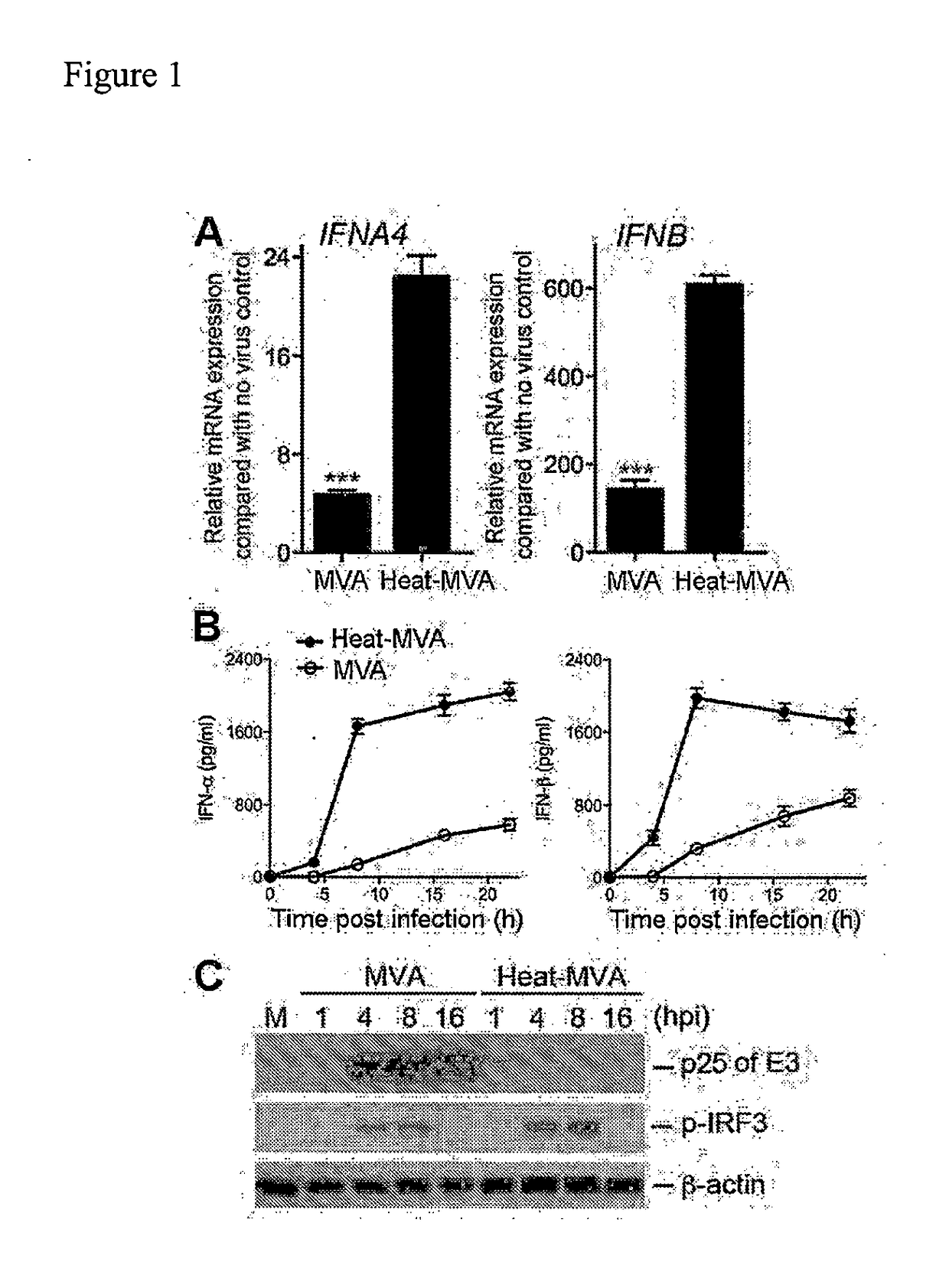Use of inactivated nonreplicating modified vaccinia virus ankara (MVA) as monoimmunotherapy or in combination with immume checkpoint blocking agents for solid tumors
a non-replicating, mva technology, applied in the field of immunotherapy, can solve the problems of evasion of anti-tumor immune response, significant therapeutic challenges, poor prognosis of people with metastatic melanoma,
- Summary
- Abstract
- Description
- Claims
- Application Information
AI Technical Summary
Benefits of technology
Problems solved by technology
Method used
Image
Examples
example 1
Heat-Inactivated MVA Induces Higher Levels of Type I IFN Production in Murine cDCs Than MVA
[0185]To test whether heat-inactivation of MVA (Heat-MVA) would result in higher levels of type I IFN induction than MVA, MVA was incubated at 55° C. for 1 h, which resulted in the reduction of infectivity by 1000-fold. Bone marrow-derived dendritic cells were cultured in the presence of GM-CSF (GM-CSF-BMDCs or cDCs) and infected with either MVA at a multiplicity of infection (MOI) of 10 or with an equivalent amount of Heat-MVA. Cells were harvested at 6 h post infection and quantitative real-time PCR analysis of RNA isolated from infected cells and mock-infected cells was performed. It was found that MVA infection of cDCs increased IFNA4 and IFNB mRNA levels by 4.8-fold and 148-fold, respectively, compared mock-infected cells. By contrast, infection of Heat-MVA dramatically increased IFNA4 and IFNB mRNA levels by 22.4-fold and 607-fold, respectively (FIG. 1A). These results indicate that Heat...
example 2
Heat-MVA-Induced Type I IFN Production is Dependent on the Cytosolic DNA-Sensing Pathway Mediated by cGAS / STING, and Transcription Factors IRF3 / IRF7, and IFNAR1
[0187]To test whether Heat-MVA infection of cDCs triggers type I IFN induction via the cytosolic DNA-sensing pathway mediated by the cytosolic DNA sensor cGAS (cyclic GMP-AMP synthase) [62, 63], and its adaptor STING [59, 69], cDCs were generated from cGAS− / − [86] mice and age-matched WT controls and infected with Heat-MVA. Using quantitative real-time PCR analysis, it was found that Heat-MVA-induced IFNA4 and IFNB gene expression at 6 h post infection were both diminished in cGAS-deficient cells (FIGS. 2A, 2B). Analysis of supernatants collected at 22 h post infection also showed that Heat-MVA-induced IFN-α / β secretion was abolished in cGAS-deficient cells (FIGS. 2A, 2B).
[0188]STING is a critical adaptor for the cytosolic DNA-sensing pathway [59, 69, 87, 88]. cDCs were also generated from STINGGt / Gt mice, which lack function...
example 3
Heat-MVA Induces Higher Levels of Type I IFN Than MVA In Vivo
[0190]To test whether Heat-MVA induces higher levels of type I IFN than MVA in vivo, Heat-MVA or MVA were inoculated into C57B / 6 mice via tail vein injection, and serum was collected at 6 h post-infection. The levels of both IFN-α and IFN-β in the serum were significantly higher in Heat-MVA-treated mice than in MVA-treated mice (FIG. 4A) (***, p<0.001). These results indicate that heat-MVA not only induces higher levels of type I IFN than MVA in cultured cDCs, but it also induces higher levels of type I IFN than MVA in vivo.
PUM
| Property | Measurement | Unit |
|---|---|---|
| temperature | aaaaa | aaaaa |
| volume | aaaaa | aaaaa |
| diameter | aaaaa | aaaaa |
Abstract
Description
Claims
Application Information
 Login to View More
Login to View More - R&D
- Intellectual Property
- Life Sciences
- Materials
- Tech Scout
- Unparalleled Data Quality
- Higher Quality Content
- 60% Fewer Hallucinations
Browse by: Latest US Patents, China's latest patents, Technical Efficacy Thesaurus, Application Domain, Technology Topic, Popular Technical Reports.
© 2025 PatSnap. All rights reserved.Legal|Privacy policy|Modern Slavery Act Transparency Statement|Sitemap|About US| Contact US: help@patsnap.com



